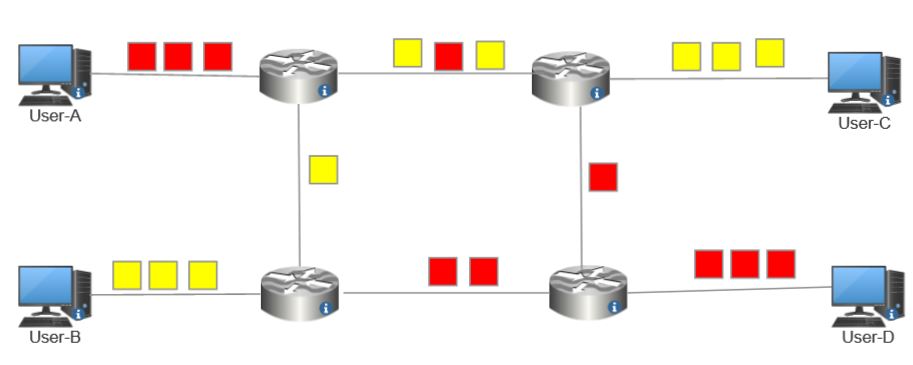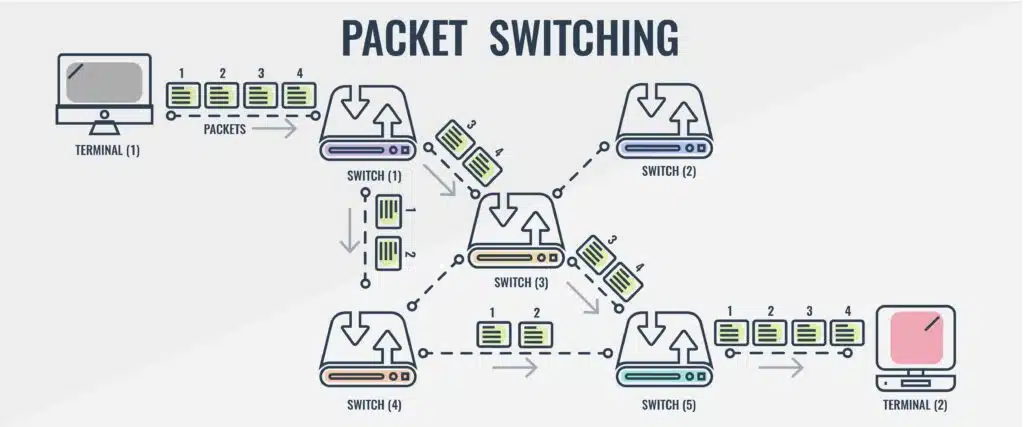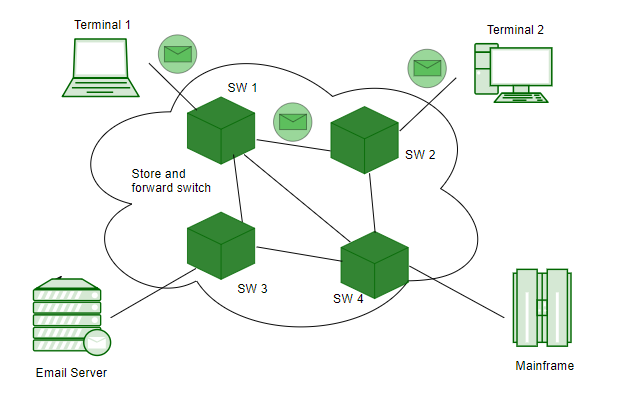“Packet Switching: The Backbone of Modern Communication
Artikel Terkait Packet Switching: The Backbone of Modern Communication
- The Rise Of The Specialized: Diving Deep Into The World Of AI Chips
- Parallel Processing: Unleashing The Power Of Concurrent Computation
- Delving Into The Private Cloud: A Comprehensive Guide
- Single Sign-On (SSO): Your Key To Seamless And Secure Access
- Progressive Web Apps: The Future Of Web Experiences
Table of Content
Video tentang Packet Switching: The Backbone of Modern Communication
Packet Switching: The Backbone of Modern Communication

In the digital age, instant communication is taken for granted. We effortlessly stream videos, browse websites, and send emails, often without considering the intricate processes that make it all possible. At the heart of this seamless connectivity lies a fundamental technology called packet switching.
Packet switching is a method of transmitting data over a network by dividing it into small units called packets. Each packet contains a portion of the data being sent, along with addressing information that allows it to be routed independently across the network to its final destination. This contrasts sharply with older circuit-switched networks, like traditional telephone lines, which establish a dedicated, continuous connection between two points for the duration of a communication session.
The Evolution from Circuit Switching:
To understand the significance of packet switching, it’s helpful to consider its predecessor: circuit switching. In a circuit-switched network, a physical path is established between the sender and receiver before any data is transmitted. This path remains dedicated solely to that communication, even if no data is being sent. Think of it as building a private highway just for your car to travel from point A to point B.
While reliable, circuit switching has several limitations:
- Inefficient Resource Utilization: The dedicated path remains idle during periods of silence or inactivity, wasting valuable network resources.
- Fixed Bandwidth: The bandwidth allocated to the circuit is fixed, regardless of the actual data being transmitted. This can lead to underutilization of bandwidth during low-activity periods and congestion during peak times.
- Susceptible to Failure: If any part of the dedicated circuit fails, the entire communication session is disrupted.
- Scalability Challenges: Establishing and maintaining dedicated circuits for a large number of users becomes increasingly complex and expensive.

Packet switching emerged as a more efficient and flexible alternative. It addressed the limitations of circuit switching by allowing multiple users to share network resources dynamically.
How Packet Switching Works: A Detailed Look:
The process of packet switching involves several key steps:
- Data Segmentation: The data to be transmitted is divided into smaller packets. The size of these packets is typically limited to a few thousand bytes, often dictated by the network protocol in use (e.g., Ethernet, IP).
- Packet Header Creation: Each packet is encapsulated with a header containing crucial information, including:
- Source Address: The address of the sender.
- Destination Address: The address of the intended recipient.
- Sequence Number: A number indicating the packet’s position within the overall data stream. This is essential for reassembling the data in the correct order at the destination.
- Error Detection Code: A checksum or other error-detecting code used to verify the integrity of the packet during transmission.
- Protocol Information: Information about the protocol being used (e.g., TCP, UDP).

- Routing and Forwarding: Each packet is then routed independently through the network. Routers and switches act as intermediaries, examining the destination address in the packet header and forwarding the packet along the most appropriate path towards its destination. This path is determined by routing algorithms, which constantly analyze network conditions to find the most efficient routes. Unlike circuit switching, packets from the same source-destination pair may take different paths, depending on network congestion and availability.
- Reassembly: Once all the packets reach the destination, they are reassembled based on the sequence numbers in the packet headers. The reassembly process ensures that the data is reconstructed in the correct order, even if the packets arrived out of sequence.
- Error Checking and Correction: The error detection code in each packet is used to verify the integrity of the data. If errors are detected, the recipient may request retransmission of the corrupted packet.

Types of Packet Switching:
There are two primary types of packet switching:
- Datagram Packet Switching: In this type, each packet is treated as an independent entity and routed individually. Routers make forwarding decisions based solely on the destination address in the packet header, without considering any previous or subsequent packets. This approach offers flexibility and resilience, as packets can adapt to changing network conditions. However, it also means that packets may arrive out of order or even be lost. Protocols like UDP (User Datagram Protocol) are commonly used with datagram packet switching.
- Virtual Circuit Packet Switching: This type establishes a logical connection, or virtual circuit, between the sender and receiver before any data is transmitted. All packets associated with a particular communication session follow the same path through the network. This approach provides a more reliable and predictable delivery of data, as packets are guaranteed to arrive in order. However, it requires more overhead for connection establishment and maintenance. Protocols like TCP (Transmission Control Protocol) are commonly used with virtual circuit packet switching.
Advantages of Packet Switching:
Packet switching offers several significant advantages over circuit switching:
- Efficient Resource Utilization: Network resources are shared dynamically, allowing multiple users to transmit data simultaneously. This leads to higher overall network efficiency.
- Flexibility and Adaptability: Packets can be routed independently, allowing the network to adapt to changing conditions, such as link failures or congestion.
- Scalability: Packet switching networks can easily scale to accommodate a large number of users and devices.
- Cost-Effectiveness: The shared use of network resources makes packet switching a more cost-effective solution than circuit switching.
- Error Detection and Correction: Built-in error detection and correction mechanisms ensure the integrity of the data being transmitted.
Disadvantages of Packet Switching:
While offering numerous benefits, packet switching also has some potential drawbacks:
- Variable Delay: Packets may experience variable delays as they traverse the network, depending on network congestion and the path they take. This can be a concern for real-time applications, such as voice and video conferencing.
- Overhead: The packet header adds overhead to each packet, reducing the effective bandwidth available for transmitting data.
- Complexity: Implementing and managing packet switching networks can be more complex than circuit switching networks.
The Role of Packet Switching in the Internet:
Packet switching is the fundamental technology underlying the Internet. The Internet Protocol (IP) is a connectionless, datagram-based protocol that relies on packet switching to transmit data across the network. Each packet is routed independently from source to destination, allowing for efficient and flexible communication across the vast and diverse network that is the Internet.
Conclusion:
Packet switching has revolutionized the way we communicate and access information. By dividing data into small packets and routing them independently across the network, it enables efficient resource utilization, flexibility, scalability, and cost-effectiveness. While it has some limitations, the advantages of packet switching far outweigh its drawbacks, making it the backbone of modern communication networks, including the Internet. As technology continues to evolve, packet switching will undoubtedly play an increasingly important role in shaping the future of digital communication.
Frequently Asked Questions (FAQ) about Packet Switching:
Q: What is the difference between packet switching and circuit switching?
A: Circuit switching establishes a dedicated connection between two points for the duration of a communication session, while packet switching divides data into packets and routes them independently across the network. Circuit switching is like having a private highway, while packet switching is like using a shared road system.
Q: What are the two main types of packet switching?
A: The two main types are datagram packet switching and virtual circuit packet switching. Datagram switching treats each packet independently, while virtual circuit switching establishes a logical connection before transmitting data.
Q: What is a packet header?
A: A packet header is a section of data attached to the beginning of each packet. It contains information such as the source address, destination address, sequence number, error detection code, and protocol information.
Q: Why is packet switching used on the Internet?
A: Packet switching is used on the Internet because it’s efficient, flexible, scalable, and cost-effective. It allows multiple users to share network resources dynamically and adapts to changing network conditions.
Q: What are some of the disadvantages of packet switching?
A: Some disadvantages include variable delay, overhead due to packet headers, and increased complexity compared to circuit switching.
Q: What is TCP and UDP, and how do they relate to packet switching?
A: TCP (Transmission Control Protocol) and UDP (User Datagram Protocol) are transport layer protocols that use packet switching. TCP is connection-oriented and provides reliable, ordered delivery of data, while UDP is connectionless and offers faster, but less reliable, data transfer. TCP is associated with Virtual Circuit Packet Switching and UDP is associated with Datagram Packet Switching.
Q: How does packet switching handle errors?
A: Each packet contains an error detection code. The recipient uses this code to verify the integrity of the data. If errors are detected, the recipient may request retransmission of the corrupted packet.
Q: Can packets from the same message take different routes?
A: Yes, in datagram packet switching, packets from the same message can take different routes across the network, depending on network congestion and availability.
Q: What are routers and switches, and what role do they play in packet switching?
A: Routers and switches are network devices that forward packets between networks. They examine the destination address in the packet header and use routing algorithms to determine the best path for each packet.
Q: Is packet switching used for voice calls?
A: Yes, Voice over IP (VoIP) uses packet switching to transmit voice data over the Internet. This technology breaks down voice signals into packets, which are then transmitted and reassembled at the destination.
Conclusion:
Packet switching has fundamentally transformed the landscape of communication, enabling the vast and interconnected world we experience today. Its ability to efficiently share network resources, adapt to changing conditions, and scale to accommodate a growing number of users has made it the cornerstone of the Internet and other modern communication networks. While challenges such as variable delay and overhead exist, the advantages of packet switching far outweigh its drawbacks. As we continue to rely on digital communication for everything from entertainment to commerce, packet switching will remain a critical technology, constantly evolving to meet the demands of an increasingly connected world. Its ongoing development and optimization will be essential for ensuring the seamless and reliable flow of information that underpins our digital lives.

